Hyundai Elantra: Front Radar System / Description and operation
| Description and operation |
The System may be limited when | •
| The radar sensor or camera is blocked with a foreign object or debris. |
| •
| The camera lens is contaminated due to tinted filmed or coated windshield, damaged glass, or stuck of foreign matter (sticker, bug, etc.) on the glass. |
| •
| Inclement weather such as heavy rain or snow obscures the field of view of the radar sensor or camera. |
| •
| The target in front is too small to be detected. |
| •
| The vehicle in front is an oversize vehicle or trailer that is too big to be detected by the camera recognition system (for example a tractor trailer, etc.). |
| •
| The camera's field of view is not well illuminated (either too dark or too much reflection or too much backlight that obscures the field of view) |
| •
| The vehicle in front does not have their rear lights ON or their rear lights are located in an unusual location (modified). |
| •
| The windshield glass is fogged up and the clear view of the road has been obstructed. |
| •
| The camera or radar is damaged. |
|
System Flow
| A Type (Front rader none apply) |
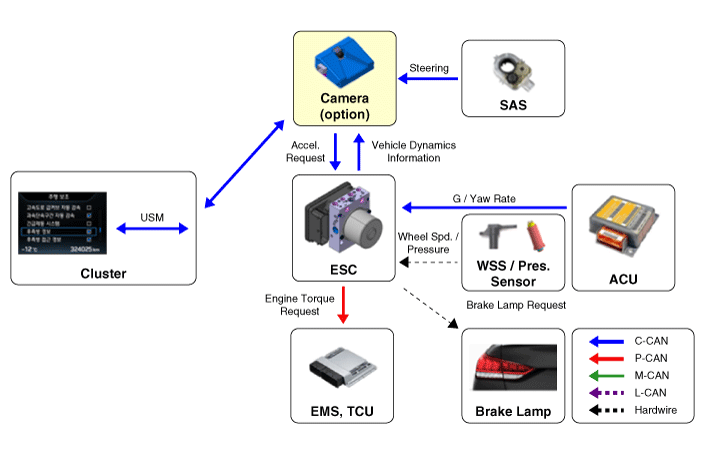
| B Type (Front rader apply) |
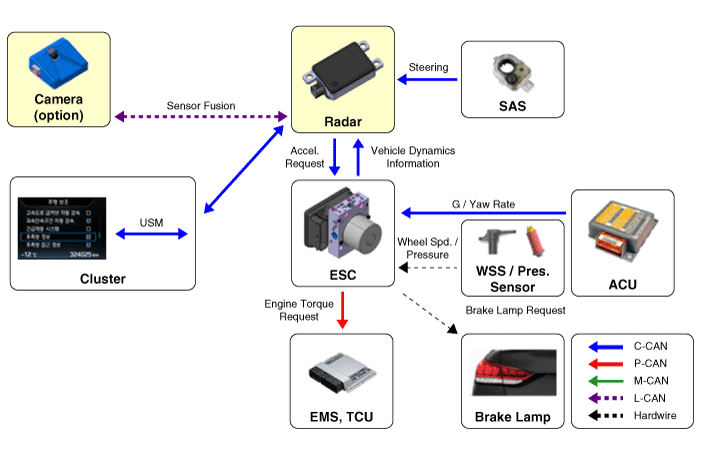
| •
| Rader, Camera : Detection device (radar and camera) that can recognize potential obstacles in the front. |
| •
| Cluster : Human-Machine Interface (HMI) to warn driver or change settings. |
| •
| ESC : Braking system to automatically brake the car |
| •
| Sensors : FCA, contrary to FCA (Smart Cruise Control), has to work on a stationary car so the system uses the Fusion Target system to combine radar with camera. |
|
System description
The smart cruise control system allows a driver to program the vehicle to control the speed and following distance detecting the vehicle ahead without depressing the brake pedal and the accelerator pedal.
| 1. | FCA : Forward Collision-avoidance Assist | (1) | FCA system is designed to help avoid a potential collision or reduce its impact when drivers applies inadequate, delayed or no brakes at all to avoid a collision. |
| (2) | The system detects the risk factors on the road by using the frontal impact sensor and warn the driver and activate the emergency brake to prevent collision or reduce collision speed. |
|
| 2. | SCC : Smart Cruise Control | (1) | Cruise speed control : The vehicle maintains the selected speed if there are not vehicles ahead. |
| (2) | Retardation control : The vehicle decelerates if a vehicle ahead is detected. |
| (3) | Following distance control : The vehicle maintains the selected following distance. |
| (4) | Acceleration control : The vehicle accelerates to the selected speed if a vehicle ahead is not detected. 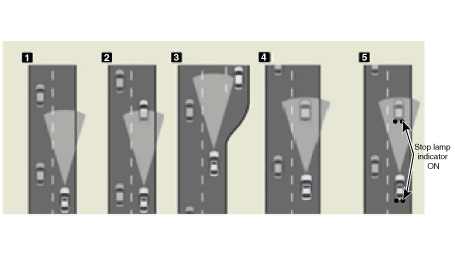
|
|
System function
| 1. | Control on curves | (1) | The sensor may not detect a vehicle ahead or may detect a vehicle on other lanes because the detection range of the sensor is limited. |
| (2) | On curves, if the vehicle equipped the SCC is driving at high speed, the vehicle can slip outside. Therefore reduce the speed on curves even there is not a vehicle ahead. (There is no brake control by SCC.) |
| (3) | While the vehicle follows a vehicle ahead on straight road, if the vehicle ahead enters on curve, the vehicle equipped the SCC may accelerate to follow the vehicle ahead. |
| (4) | On curves, if a vehicle ahead followed is out of range, the vehicle does not accelerate to the set speed and maintain the following speed to prevent from accelerating and decelerating repeatedly. (If the vehicle equipped the SCC changes the lane or apply the accelerator pedal, the vehicle will accelerate.) |
|
| 2. | Warning alarm If the vehicle equipped the SCC decelerates because a vehicle ahead decelerates or moves into your lane, the warning will operate. | (1) | In case that the vehicle equipped with SCC is able to decelerate properly by the system – No warning |
| (2) | In case that the vehicle equipped with SCC is not able to decelerate properly by the system | –
| Indicator in the cluster will blink and the warning buzzer will sound. (The warning and deceleration by the system will go on until the brake pedal is applied.) |
|
| (3) | If the vehicle ahead (vehicle speed: less than 30km/h) disappears to the next lane during following distance control, the warning chime will sound and a message will appear. Adjust your vehicle speed for vehicles or objects that can suddenly appear in front of you. |
|
| 3. | Accelerating by driver Even the vehicle is being decelerated by the SCC system, the vehicle can be accelerated by applying the accelerator pedal. If the vehicle is accelerated above the set speed, the indicator in the cluster will blink. |
| 4. | Function of cruise control | (1) | The driver may choose to only use the cruise control mode (speed control function) by doing as follows: |
| (2) | With the smart cruise control system on (the cruise indicator light will be on but the system will not be activated), push the distance to distance switch for more than 2 seconds. "Smart cruise control (SCC) mode" and "Cruise control (CC) mode" can be selected.The speed control of the cruise control mode is the same as that of the smart cruise control mode. |
| (3) | When using the cruise control mode, the driver must manually access the distance to other vehicles as the system will not automatically brake to slow down for other vehicles. |
|
| 5. | Autonomous Emergency Braking function | (1) | It is a driving convenience system that controls the steering and speed to keep the safe distance from the vehicle ahead and to prevent lane departure on highway while Smart Cruise Control is operating. |
|
| 6. | Highway Driving Assist (HDA) function | (1) | It is a driving convenience system that controls the steering and speed to keep the safe distance from the vehicle ahead and to prevent lane departure on highway while Smart Cruise Control is operating. |
|
System Operation
FCA : Forward Collision-avoidance Assist)
| 1. | Basic specification (front camera applied) 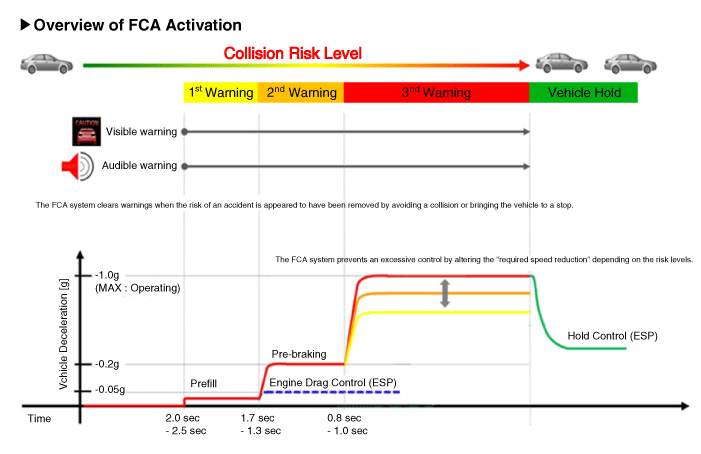
※ The time indicated will be changed according to vehicle speeds. | •
| Step 1 : Issue a visual (display) and vocal alarm when a danger is detected. |
| •
| Step 2 : Reduce engine torque and activates FCA when there is a high chance of collision. |
| •
| Step 3 : Activate emergency brake when a collision is imminent. |
| •
| After stopping the vehicle : Maintain the braking control for a certain time and then release it. |
| •
| Braking power is adjusted depending on the risk levels of collision, but it is released immediately when it detects the driver's action to avoid a collision. |
| 1) | When it exceeded the maximum operation speed. |
| 2) | When it detected driver's action to avoid a collision such as sudden steering changes. |
| 3) | When the shift lever is in R or P |
| 4) | When you pressed the accelerator pedal half way. |
|
| 1) | When you drive at 60km/h - 180km/h or faster, the system does not go to step 3 of emergency braking. - Full auto braking is not available. |
| 2) | When you drive at 60km/h or faster, the system does not go to step 3 of emergency braking. - But a collision may occur at depending on the road conditions. |
| 3) | Offset should be less than 50%. |
| 4) | FCA does not work on the vehicles backing up or resisting. |
|
Offset : Rate of non-overlapping on the line between the front driving car and my car | 1) | Offset 0% : 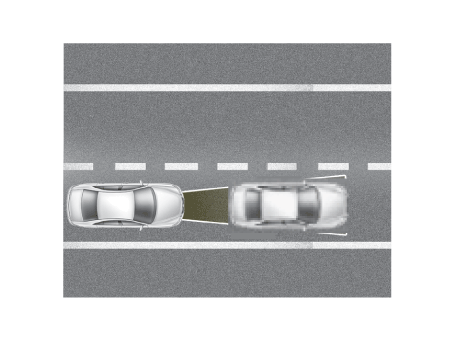
|
| 2) | Offset 100% : 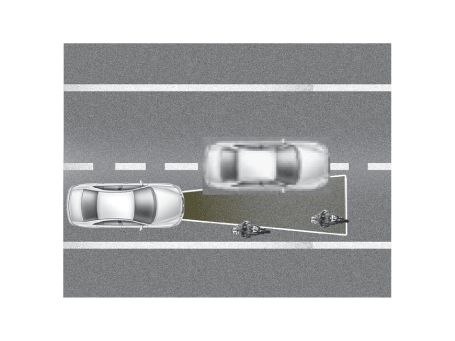
|
|
|
| 2. | When the Smart Cruise Control is applied at the same time (front radar added) 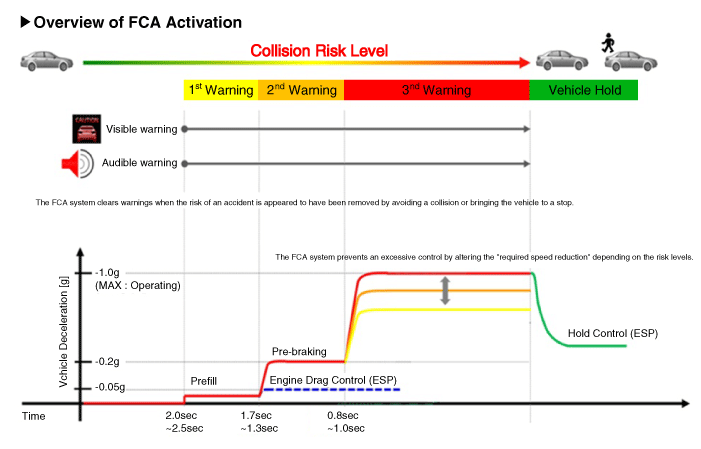
The time indicated will be changed according to vehicle speeds. | •
| Step 1 : Issue a visual (display) and vocal alarm when a danger is detected. |
| •
| Step 2 : Reduce engine torque and activates FCA when there is a high chance of collision. |
| •
| Step 3 : Activate emergency brake when a collision is imminent. |
| •
| After stopping the vehicle : Maintain the braking control for a certain time and then release it. |
| •
| Braking power is adjusted depending on the risk levels of collision, but it is released immediately when it detects the driver's action to avoid a collision. |
| 1) | When it exceeded the maximum operation speed. |
| 2) | When it detected driver's action to avoid a collision such as sudden steering changes. |
| 3) | When the shift lever is in R or P |
| 4) | When you pressed the accelerator pedal half way. |
|
| 1) | When you drive at 85km/h - 180km/h or faster, the system does not go to step 2 of emergency braking. - Full auto braking is not available. |
| 2) | When you drive at 85km/h or faster, the system does not go to step 3 of emergency braking. - But a collision may occur at depending on the road conditions. - Partial braking may be applied according to the surrounding environment. - For the vehicle parked in front, full braking is applied at level 3 after the warning only when the vehicle speed is under 75 km/h. Up to level 2 is performed when the vehicle speed is over 75 km/h. - For the pedestrian and cyclists, full braking is applied at level 3 after the warning only when the vehicle speed is under 65 km/h. Up to level 1 is performed when the vehicle speed is over 65 km/h. |
| 3) | Offset should be less than 50%. |
| 4) | FCA does not work on the vehicles backing up or resisting. |
|
Offset : Rate of non-overlapping on the line between the front driving car and my car | 1) | Offset 0% : 
|
| 2) | Offset 100% : 
|
|
|
SCC : Smart Cruise Control
| 1. | Smart cruise control operating mode. 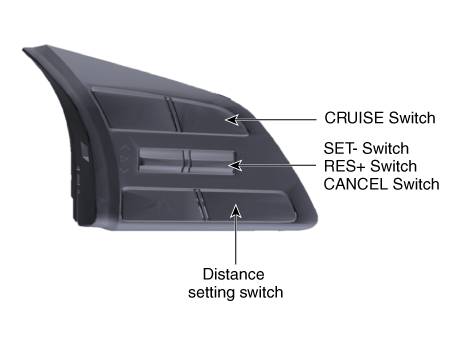
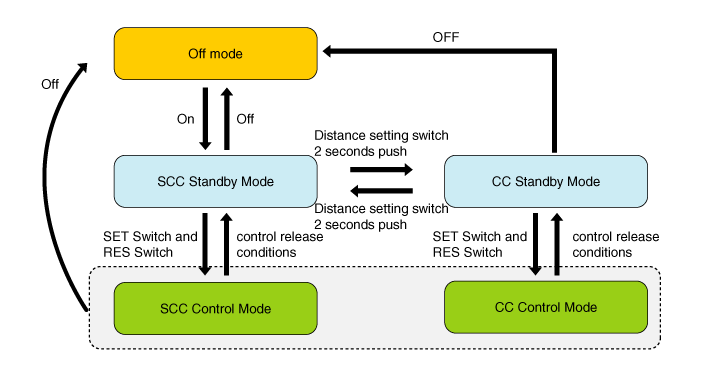
| •
| SCC : Smart Cruise Control |
|
|
| 2. | Smart cruise control operating conditions. | (1) | Vehicle speed at approximately 0-160km/h (0-99.4mph) |
| (2) | Transmission in D or Sports mode |
| (4) | "CRUISE" switch ON (CRUISE indicator ON) |
|
| 3. | Smart cruise control disabling conditions | (5) | Vehicle speed at more than approximately 160km/h (99.4mph) |
| (6) | Vehicle speed at less than approximately 10km/h (5mph) |
| (7) | Transmission in N or P or R |
| (8) | ESP/ TCS / ABS certain period of time operating |
| (9) | An accelerator pedal applied for more than 5min |
| (10) | ESP OFF" switch ON (ESP OFF indicator ON) |
| (11) | Parking brake applied |
| (12) | System failure (The warning indicator ON) |
| (13) | Crack, damage or wrong installation of smart cruise control unit cover (The warning indicator ON) |
|
General Safety Information and Caution1.Be careful when driving the vehicle using the smart cruise control system as follows.(1)On curves or inclines/declines•
The smart cruise control system may have limits to detect distance to the vehicle ahead due to road and traffic conditions...
Components Location1. Remote control switch (LH : Audio swtich)2. Remote control switch (RH : Cruse)3. Front rader unit..
Other information:
Repair procedures
Removal and Installation1.Disconnect the battery negative terminal.2.Remove the engine room under cover.(Refer to Engine and Transaxle Assembly - "Engine Room Under Cover")3.Disconnect the intercooler inlet hose (A). Tightening torque : Clamp bolt : 4.9 - 6.9 N.m (0.5 - 0.7 kgf.m, 3.6 - 5.1 lb-ft)
•
Insert the hose..
In this mode, you can change the
settings of the instrument cluster, doors,
lamps, etc.
1. Driver Assistance
2. Door
3. Lights
4. Sound
5. Convenience
6. Service interval
7. Theme selection
8. Other
9. Language
10. Reset
Shift to P to edit settings / Engage parking
brake to edit settings
This warning message illuminates if
you try to select an item from the User
Settings mode while d..


 General safety information and caution
General safety information and caution Components and components location
Components and components location









.png)
.png) or
or
.png) position.
position.